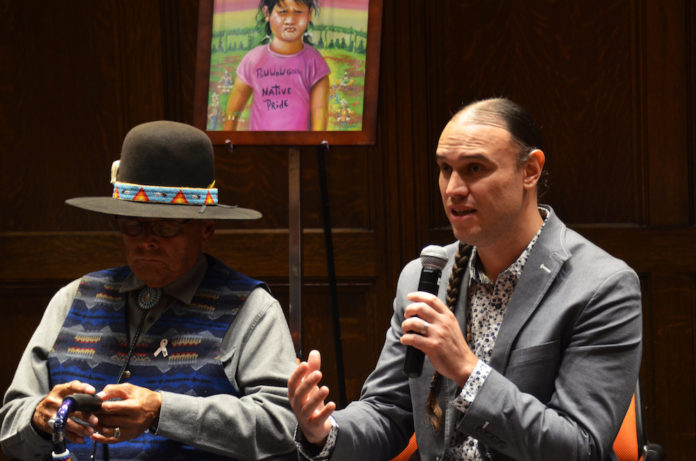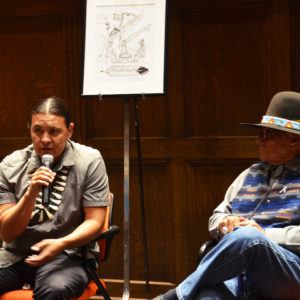
Indigenous speakers representing the Tongva/Acjachemen, Hunkpapa, Oglala, Choctaw/Lakota and Itazipcho tribes came to Occidental to present a panel about Native Americans furthering their connection with their culture while in prison Oct. 10. Panelists included Tongva/Acjachemen spiritual leader Jimi Castillo, Native American activist and attorney Chase Iron Eyes and Ret. Deputy Attorney General Randall Murphy. Tria Blu Wakpa, assistant University of California, Los Angeles (UCLA) dance professor, organized and moderated the panel.
The panel promoted the opening of “Carceral Liberation?” a UCLA-hosted art show featuring the art of indigenous people incarcerated nationwide. “Carceral Liberation” refers to the paradox of Native American people broadening their cultural connection while also being confined. While imprisonment is associated with confinement, the panelists explained how Native curricula and support is offered to many prisoners who otherwise would not have much opportunity to connect with their history and heritage.
Blu Wakpa, who curated the art show, kicked off the panel by explaining how two of her friends who helped organize the art event are currently behind bars. Blu Wakpa added that one of her friends, George Blue Bird, has been in prison for 36 years, while a white man who committed a comparable crime in the same county only received 12 years, according to Blue Bird.
According to Blu Wakpa, right before the panel, Blue Bird explained to her that even if he does not receive justice within his lifetime, he will at least feel content from the fact that his story and artwork made a tangible impact. Blu Wakpa went on to explain the necessity of understanding the context around the disproportionality of Native American incarceration.
“We cannot begin to understand Native imprisonment without considering the damage that U.S. colonization has caused, and continues to cause, through denying Native nations sovereignty,” Blu Wakpa said. “Damage is also perpetuated through the forced removal of Native people from their lands, relocation, assimilation, boarding schools and detention centers.”
Castiello spoke about his work as a spiritual advisor in multiple California prisons including San Quentin, Donovan, Chowchilla and Holcomb. According to Castiello, in his 26 years of working at the prisons, the sacred spaces where he practiced his spirituality remained the one space inmates occupied where blood was never spilled.
“So I want to say that behind those tattoos, and hard looks and bald heads and everything is a real live human being with warm blood flowing through their veins,” Castiello said. “Just starving for affection.”
Blu Wakpa also made the point that the overrepresentation of indigenous people within U.S. prisons is no coincidence.
“Understanding the structural inequities that lead to indigenous incarceration reveals that many so-called perpetrators are also victims of an unjust system,” Blu Wakpa said.

Murphy shared a bit about his background and explained how before going to law school he became a furlough supervisor for Native Americans in a Nebraska prison. As a furlough supervisor, he could take prisoners for indigenous culture-related trips outside the jail.
“Before they had gotten to prison, many of them had very tangential interactions with Native American spiritual and traditional belief systems. But once they got to prison and were exposed to different ceremonies, they became more involved with traditional practices,” Murphy said.
Murphy said the reconnection and exposure for the inmates to their Native roots was incredibly healing for them.
According to Blu Wakpa, misrepresentation and exclusion of Native culture and history within classrooms continues to be inflicted on the Native community with profoundly negative impacts. Blu Wakpa stated that the city of LA took a step in the right direction by celebrating the first Indigenous Peoples’ Day last year instead of the federally recognized holiday, Columbus Day.
One picture brought to the panel was a painting by the famous Native American activist Leonard Peltier. According to Blu Wakpa, Peltier has served more than 40 years for a crime he did not commit.
“Peltier’s painting celebrates the endurance, longevity and futurity of Native people’s practices and lands,” Blu Wakpa said.
In the foreground, a contemporary indigenous girl wears a T-shirt with the words “Pow-wow girl, Native pride.”
“Carceral Liberation?” runs until Nov. 2 at 131 N. Avenue 50, Los Angeles, CA.
10/28/19: Edited to correct Tria Blu Wakpa’s name and role in the panel.
![]()


































